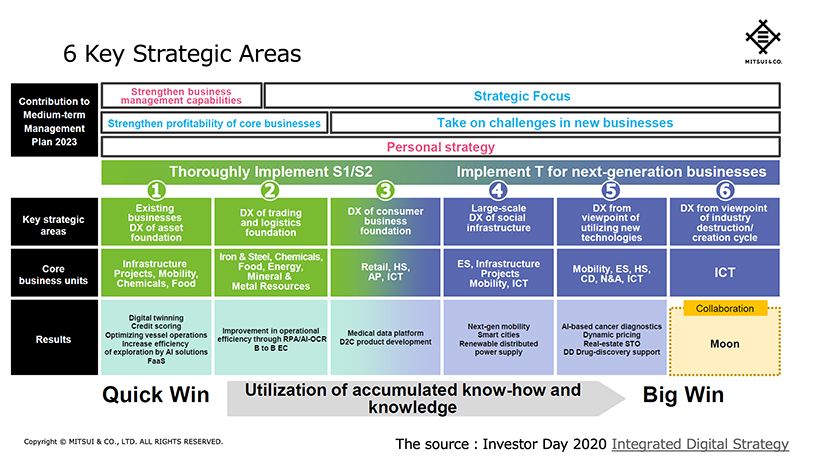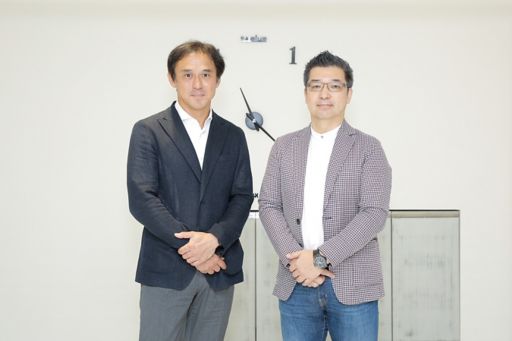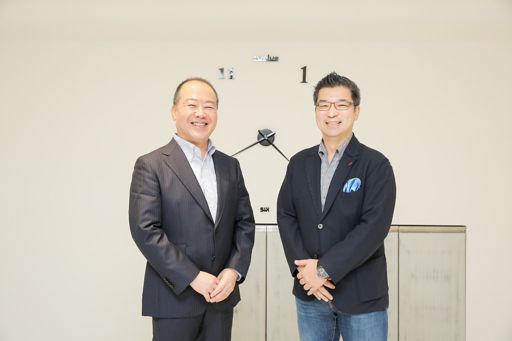”Large companies are the ones that need to seriously work on digital management” --- we hear a lot of similar opinions today, especially after the pandemic. There are actually corporations currently working on this challenge, including those that have already paved their way for transformation.
What kind of path did these companies follow? What kind of future are they seeing? And what are the company’s unwavering fundamentals that can be found? --- In this article, we will introduce the discussions conducted between Yuji Mano from Mitsui & Co., Ltd.’s Integrated Digital Strategy Division and Masayuki Chatani from KPMG Ignition Tokyo.
Contents
- Link to Vol. 1
- Link to Vol. 2
- Collaboration with IHH, the Largest Private Hospital Group in Asia
- Directions on How to Apply Digital Technologies to Human Rights and Business Issues — How We Should Manage Increasingly Complex and Multi-layered Supply Chains
- How Will Mitsui Transform Its Business to Digital Native?
The Theory of Evolution for Trading Companies — What Would They Look Like in 30 and 50 Years?
- Profile of Interviewee
Collaboration with IHH, the Largest Private Hospital Group in Asia

(Yuji Mano, Managing Officer, General Manager of Integrated Digital Strategy Division of Mitsui & Co., Ltd. (left), Masayuki Chatani, Representative Director & CEO of KPMG Ignition Tokyo and CDO of KPMG Japan (right)) *Professional affiliation and official position in the article are at the time of publication.
Chatani: I have heard earlier that you are also working on a new initiative with IHH, the largest private hospital group in Asia. Are the human resources procured within Singapore?
Mano: Yes, the initiative with IHH is carried out mainly in Singapore and Malaysia. In Tokyo, our DX3 Department, which is responsible for wellness and healthcare, handles it by working together with the Singaporean counterpart.
Chatani: I believe that you are supporting the ‘patient experience’ policy held up by IHH. What is your goal in this endeavor?
Mano: We want to enhance the value of patient experience by leveraging IHH data.
My understanding is that there are two objectives in this initiative and a cluster of data at the center. From this center, two business categories branch out into two directions: one is to achieve organizational efficiency of hospital business and the other is to develop new businesses driven by data. We will be pursuing both of these goals.
With regard to patient experience in particular, we consider what we can do to help shorten patients’ waiting time and address patients’ worries on medical costs for those who live in overseas locations where national health insurance program is not available unlike Japan ( i.e., how much will the medical cost be?). By utilizing all the accumulated data, we could estimate expected diagnosis prior to starting the treatment as accurately as possible (e.g., one should expect this much in medical costs for a particular condition’s diagnosis/treatment) to help patients determine the level of treatment they could receive.
Furthermore, efforts to do everything we can to promote enhancement of patients’ well-being, such as support for telemedicine, AI diagnosis, etc., are also included in the scope of the initiative.
As for the data-driven businesses, we are working on the initiative to find ways to eliminate the need to see the doctor while also supporting achievement of efficient hospital management. It pertains to a pre-symptomatic state or wellness area. We are currently working to create a system to help people eliminate the need to see the doctor, as a part of personal disease prevention or health management practice, by using patients’ data.
Chatani: Japan has also experienced medical crisis during the COVID-19 pandemic, and people pointed out the need for technological advancement. I hope that Japan will also start such an initiative soon.
Mano: Yes, I hope so too. The reason why we started this in the Asian region outside of Japan is because it is difficult to get through new ideas in Japan due to strict legal restrictions on medical-related affairs (though this situation is unavoidable to some extent). This is why we decided to start it in the other Asian regions first.
Directions on How to Apply Digital Technologies to Human Rights and Business Issues — How We Should Manage Increasingly Complex and Multi-layered Supply Chains
Chatani: These days, I must ask this question too. At Mitsui & Co., how do you deal with ESG or SDGs?
Mano: Today, these topics have become the central part of our business management. Let me briefly share my background. Before taking on my current position, I was working in Investor Relations (IR), so engagements with investors was one of my primary responsibilities. Since some of our businesses, such as oil, coal, and power generation, cause greenhouse gas emissions, our company, especially the management, is highly aware of sustainable issues. Against this backdrop, we are now actively working on changing our business portfolio.
Although there is no doubt that reduction of greenhouse gas is important, focusing on this alone would lead to simply reducing our main businesses (power-related businesses, mining, etc.), making our company unprofitable. What we have to do instead is find an alternative business with great potential and focus on it.

As for ESG, in terms of “E” (environment), we are actively promoting an ambitious business that also takes decarbonization into account, which we plan to further accelerate in the future. For “S” (social), not only human resources development but also establishment of a supply chain that considers human rights is one of the most important. While supply chains are extremely important for trading companies, we are currently doing deep thinking to ensure that there are no human rights issues (e.g., how to prove our opting for fair trading as much as possible).
I think the key to the solution will be the block chain technologies. We have just started examining how to apply this technology.
Chatani: The supply chains and human rights issues have also become a topic of interest in Japan, and as for agricultural products, there is a growing awareness to place greater importance on traceability, including food safety. Is Mitsui going to start developing the block chain in-house?
Mano: We are testing with internal and external resources. For example, to address the human rights business issues, we had conducted a traditional survey for our suppliers, and set up rules to promote sustainability to perform checks accordingly. Selecting trading partners with ISO certification is also a basic step we can take.
However, to ensure greater transparency and validity, we want to be able to check these things digitally in the future by using block chain technologies. I believe we will be able to do this in the near future as our company is currently conducting demonstration experiments.
Chatani: My understanding of ESG and SDGs from audit/tax perspectives is that companies will be evaluated based not only on numbers presented in the financial statements but also on some sort of corporate “personality” or “character”.
In this sense, the process of validating the supply chain you had mentioned just now, might be annoying as it is unstructured and involves information that is not written in natural language or Japanese. At Mitsui, what kind of measures will be taken to address these things?
Mano: There is no doubt that we need to collect a wide variety of information as our data. One of the points raised in doing so is how to collect the data itself. For example, let us imagine the supply chain situation in Africa. We handle a variety of agricultural products. How do we collect data from the farms and logistics? How can we have the farms, the starting point of the supply chain, input data? What can we do to make it possible? These are tough challenges.
We probably could process the input data and use them to some extent, but we have to be creative with the input part. I am afraid that we can’t share the details, but we are aware of the importance of setting up the right structure.
Chatani: That is exactly where UX comes into play. Rather than promoting DX or implementing technologies, we need to design our system by closely observing human psychology and considering how to have people input the right data.
How Will Mitsui Transform Its Business to Digital Native?
Chatani: So far, we have discussed changing attitudes within the company, how to develop DX talents, and collaboration with third parties. Our talk also touched on Mitsui’s approach to UX. I believe that there are three stages in implementing DX: (1) digitalization of processes, (2) digitalization of business model, and (3) full digital transformation of business model. At Mitsui & Co., what kind of ideas do you have to make business models digital centric and transform them to digital native?
Mano: That relates to the “ambitious” part of our DX business strategy. Right now, we have identified the following six key strategic domains (refer to the image below "6 Key Strategic Areas"):
First, we will increase efficiency to reduce costs and raise the bottom line. Then, we will deepen our engagement with clients to raise the top line to expand sales. In addition, we are thinking of creating completely new businesses (i.e., ‘Transformation’
The new businesses that we are considering include consumer businesses. This genre was not exactly our strong area, but we have started getting into the development of a medical data platform I had talked about earlier, and, recently, the direct development of products for consumers as a part of B to C business.
On the other hand, the new challenges we had taken on in the areas where we have strengths include our initiatives in social infrastructure. Of these, promotion of next generation mobility and smart city is especially new to us. We have launched an initiative to analyze where the people gathering here come from, their demographics, etc., by extrapolating how they move, how they travel, and other factors with AI using the data provided by KDDI. Then, based on these data, we can consider designing urban infrastructure and mobility by automated driving.
There are also some other things. While we normally start from our business first and then look for the technologies, we are currently working on a project that started from technologies. One such example is the AI cancer diagnosis project implemented in collaboration with Preferred Networks, Inc.. This diagnosis aims to detect 13 types of cancer as early as possible using patients’ blood. This project is expected to progress to the next level soon.
Furthermore, you might be surprised to see us in this type of business, but we have been paying attention to the dynamic pricing system from its very early stage. It is a system in which big data analysis is used to estimate the demand for each game to determine the optimal ticket price. Today, there are 10 or more J-league soccer teams and about four professional baseball teams that have employed this system. We are also involved in real estate STO (Security Token Offering) and data-driven drug discovery, which are completely new challenges for us.
Chatani: All of these projects are very interesting. Where do these new businesses come from?
Mano: We have two patterns: one where people on the technologies side come up with the idea and the other where people on the business side apply the technologies.
For example, AI cancer diagnosis was proposed only by the technologies side. The idea was born in the process of collaboration with Preferred Networks, where we became aware of it and decided to dig deeper.
On the other hand, real estate STO is an example of the project where the idea proposed by the business side was combined with the technologies. It started from the business side’s search for ways to expand the investor base. In this process, they learned about the block chain and realized that this technology might be useful.
I feel that being close to the business scenes is our major strength, which we call “operation & technology”. By “equipping” these business people with digital knowledge, we can broaden our options for new businesses.
The Theory of Evolution for Trading Companies — What Would They Look Like in 30 and 50 Years?
Chatani: After listening to your story, I was surprised to learn about the types of businesses that I had never thought a trading company could be involved in. I would like to ask you the final question: in 30 and 50 years from now, do you think Mitsui & Co. will still be called a “trading company”?
Mano: That is a very compelling question. Personally, I believe that we will still be called a trading company.
I assume some readers of this article now wonder, “So, what really is a trading company?” It is very difficult to define what it is, and this is also the question I was frequently asked by investors while I was responsible for IR. We also operate iron ore, energy, food, automobile, chemical products, healthcare and financial businesses. Sometimes, this variety confused the investors and resulted in unsuccessful investment deals.

Having said this, Mitsui & Co., as a general trading company, is, after all, an enterprise that has passed on its title for over 140 years, including the time of the former Mitsui & Co.,* which was dismantled after WW2. During this 140-year period, our label remained a “general trading company”, however, people and the system behind this label have changed with the times, sometimes at a significant speed ahead of the times.
*The former Mitsui & Co., and Mitsui & Co. today are legally separate and independent entities without any continuity relationship.
Also in the past, people argued every now and then that “trading companies are unnecessary” or “dark era has come to trading companies”, yet we have survived by adopting to changes and will continue to do so in the future.
Chatani: So, what we are seeing as Mitsui & Co. today is just a temporary state?
Mano: Yes, it is. “We are doing these kinds of work but could be doing something that is nothing like what we are doing today in 30 years from now” — this is what we as a general trading company can do.
Profile of Interviewee

Yuji Mano
Managing Officer, General Manager of Integrated Digital Strategy Division
Mitsui & Co., Ltd.
Yuji Mano joined Mitsui & Co. in 1986, and was engaged in chemical sales in Japan and the United States, then transferred to Corporate Planning & Strategy Div., formed the company-wide Information Strategy Task Force in 2008 and served as the leader, and he became the first General Manager of the Information Strategy Planning Dept. in 2009. After that, he served as General Manager of Chemical Business Development Div., CAO of Mitsui Americas, and then General Manager of IR Div. in 2016. He became a managing officer in April 2019 and was General Manager of IT Promotion Div. in June of the same year. He advocated the integration of DX and IT in business strategy, and became General Manager of Integrated Digital Strategy Div., which was established as the integration of two organization in October, 2019. After that, all DX / IT related organizations that had been dispersed throughout the company were also integrated to carry out large-scale organizational restructuring, which resulted in establishment of the current Integrated Digital Strategy Div. He formulated "DX Comprehensive Strategy" and promoted digital transformation, data-driven management and DX human resources strategy for the entire Mitsui & Co. Group.
Follow us on KPMG Ignition Tokyo LinkedIn for the latest news.
Connect with us
- Find office locations kpmg.findOfficeLocations
- kpmg.emailUs
- Social media @ KPMG kpmg.socialMedia






